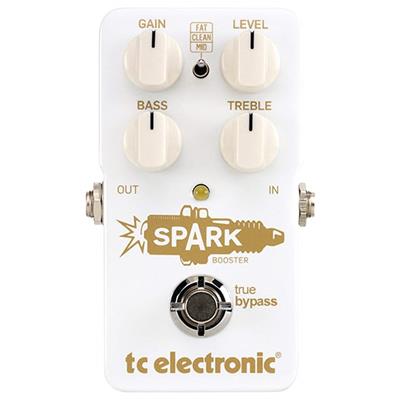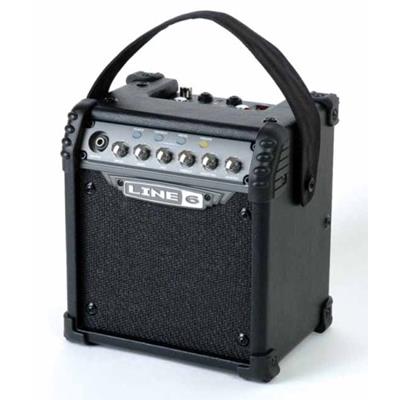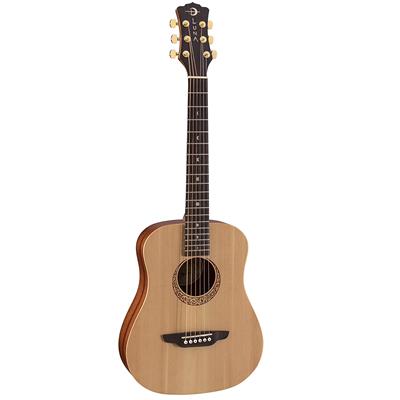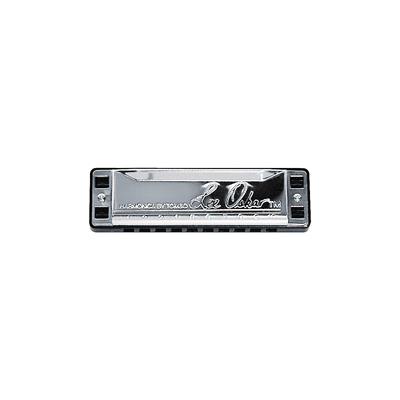Are you considering purchasing a boost pedal? Or maybe you already have one but you are looking for something better? One way or another, you are in the right place, my friend. We all know how great a boost pedal is (if not, you will find out in a bit).
It is basically a golden ticket into the world of perfect performance and defined notes. However, choosing the proper device is a bit of a headache. There is at least one boost pedal in every single price range, which makes this process even more complicated.
Luckily, I am here to help. This article will provide you with the list of the best boost pedals on the market, break down their functions and capabilities and give you some tips on their utilization. If you want to grasp this device to its core, just keep on reading!
What’s The Best Boost Pedal
Xotic RC Booster-V2 Pedal

Xotic RC Booster V2 is the revamped version of its predecessor, which proved to be a staple on many guitarists’ pedal boards. The brand decided to amp up their game and enhanced the original even more. The very first distinction that catches your eye is the number of footswitches. RC Booster V2 has two: Bypass and Gain 1+2. Let’s dig into the controls of this bad boy: Bass and Treble act as an EQ and provide you with a nice cleanse of the tone; Volume modifies the level of the overall output of the pedal, while Gain 1 boosts your sound substantially (which is enough in most cases). Moreover, there’s an additional feature to explore: a LED-illuminated knob labeled “Gain 2.” This compact knob imparts a touch of richness to your tone, enhancing its depth and providing a subtle boost. The RC Booster V2 accomplishes all of this without compromising the clarity or altering the character of your sound. Overall, you’ll quickly develop an affection for this pedal.
Pros:
- Quiet operation
- True bypass
- Great boost
- Good quality
Cons:
- Gain 2 knob is not easily accessible on the fly
- Volume knob alters your tone a bit
TC Electronic Spark Booster Pedal

TC Electronic has never failed to develop quality products. They are one of the most innovative brands out there that always have something new to say. And Spark is one of the best boost pedals I have ever played. It comes in a solid metallic body that ensures years of usage. With classic design and subtle colors, this pedal does really stand out among the crowd. When it comes to performance, this little unit gives you an array of sonic possibilities. And it does so with the help of four main knobs and a toggle switch. Bass and Treble are your standard active EQs, Level adjusts the volume of the pedal, while Gain adds some crunch and compression to your sound (depending on how you tweak it). The toggle switch provides three distinct modes to enhance your sound. The Flat mode evens out your tones and adds definition to your leads. Clean mode boosts all frequencies evenly, creating a balanced and harmonious tone. Meanwhile, the Mid mode focuses on the midrange frequencies, ensuring that every note you play is clearly audible. With its exceptional capabilities, the Spark pedal is a game-changer that will elevate your performance to new heights.
Pros:
- Does not color your tone
- Powerful performance
- Versatile sonic possibilities
Cons:
- Gain can get muddy with certain instruments
Wampler Pedals Decibel Plus V2 Boost & Buffer Effects Pedal

You already know how great Wampler pedals are. dB+ is a newer version of the Decibel+ and features all the great qualities of the original. This pedal is too simple to be true. It has a single knob labeled Boost, which makes sure that even the most inaudible tones will stand out in the mix. This little control does not let your sound get muddy. Unlike its predecessor, dB+ has an independent Buffer, that can be switched on/off according to your preferences. It features a true bypass, meaning that your tone will not be colored when the pedal is turned off. Plus, this pedal is quite small and can be placed even on the most overcrowded pedalboard. In short, if you are a simple guy and want a pedal just like you, dB+ is the way to go.
Pros:
- Easy to use
- Powerful boost
- Transparent
Cons:
- A bit pricey
Catalinbread Naga Viper Modern Treble Booster Pedal

We all remember how badass the original Dallas Rangemaster was – its legendary treble boost was so memorable that we still talk about it nowadays. However, it needed some modernization. Catalinbread took up this mission seriously and developed a Naga Viper, which operates using the same circuitry as Rangemaster. Unlike its predecessor, this bad boy has three knobs: Range allows you to control the frequency response of the pedal and dial in anything from a classic treble boost to a full range boost, Boost modifies the level of the overall output, while Heat takes over the gain of your sound. These additional features that differentiate Naga Viper and Rangemaster make the former proud rival of the well-known legend. You can get a clean boost with this pedal as well as achieve the sounds of an overdriven amp. In a nutshell, Naga Viper is one of the best boost pedals you can ever buy.
Pros:
- Offers Rangemaster sounds
- Powerful boost
- Knows how to recognize your frequencies
- Well-built
Cons:
- Can increase the noise floor in the signal chain
Fulltone Fulldrive 2 MOSFET Overdrive Boost

What we have got here is a two-in-one deal. Fulldrive 2 MOSFET is an overdrive pedal that offers a killer boost as well. At first glance, this little unit might seem like an overly complicated device, but when you start tweaking, operating it will be like a piece of cake. Let me dig into describing all the features and you will see what I am talking about. Let’s start with the knobs- we have got four of them here: Volume and Tone control the level and the presence of your sound, Overdrive modifies the gain and can act as a clean boost as well, while Boost alters the saturation of the tones when the boost control is employed. Now, let’s move on to toggle switches. The first one shifts between CompCut, FM (a.k.a. flat mids), and Vintage, which offer different modes of overdrive. The second option offers a choice between Standard and Mosfet, providing an expanded range of sonic options. Overall, the Fulldrive 2 MOSFET pedal is truly remarkable as it allows you to simultaneously enhance and amplify your sound, delivering outstanding overdrive capabilities.
Pros:
- Extremely versatile
- Offers plenty of sonic options
- Noiseless operation
Cons:
- Learning what is what is a bit time consuming
- CompCut mode can be too loud for some
J Rockett Audio Designs Archer Tour Series Overdrive & Boost

Have you ever played with the Klon Centaur Professional Overdrive? Are you in love with its amazing sound? If so, I have good news, my friend. J Rockett Audio Designs worked with the developer of the Klon, Bill Finnegan, and put together the Archer. This fella is featured as the part of Tour Series, meaning that it is super compact and portable (unlike Klon which would take up a lot of room on your pedal board). This unit is very well-built and promises to be extremely durable. Archer has three knobs: Output is your standard volume control and can act as a clean boost when the gain is not employed, Gain activates the overdrive, while the Treble sets the color of your tones while performing as an EQ as well. This pedal offers everything from clean boost to overdrive and allows you to tailor your sound to your preferences.
Pros:
- Very accurate Klon clone
- Offers pristine clean boost
- Built like a tank
Cons:
- A bit pricey
Jim Dunlop MC401 MXR Boost/Line Driver

When describing MXR Boost/Line Driver, the first word that comes to mind is simplicity. Designed in collaboration with Bob Bradshaw, this little device offers a clean boost and will aid you even in the most lost-cause situations. MC401 has a single knob that is a star of the show here. By setting it in different positions, you get an array of results. This unit can enhance the volume on the pedals that drop the level of your output, overdrive your amp to achieve those sweet classic tones, or merely boost your instrument so that your notes do not fade away during performance. Another cool thing about MC401 is its Line Driver feature. This is basically a circuit operating this pedal, which guarantees that your tones are not sucked and tangled in the long cables of your chains. In short, MXR Boost/Line Driver is everything you could wish for featured in a simple, yet reliable design.
Pros:
- Well-built
- Perfect boost
- Adds definition to your sound
Cons:
- Does not have an EQ
- It can slightly color your wet signal
Xotic EP Booster Mini EQ Effect Pedal

Every time I review Xotic pedals, I cannot help praising the quality of their products. I mean there are staples in the music industry and this brand is the definition of that phenomenon. EP Booster mini comes from the same league and offers way more than you would think. Let’s start with on-the-surface features: it has a single knob that modifies the amount of boost (up to +20dB) added to your sound. However, there is a lot more under the hood. This pedal has an internal dip switch, which allows you to set the minimum amount of boost (0 or +3dB gain). It also has an internal Bright Switch that lets you alter the EQ and choose between Flat and Vintage modes. Even though it might not seem like it, EP Booster gives you everything you would require from a boost pedal. Plus, it will give you a flashback of the legendary Echoplex. What else could you wish for?
Pros:
- Makes your sound thicker
- Echoplex sound
- Offers plenty of options, compact size
Cons:
- Would be better if the EQ was featured on the surface
TC Electronic Spark Mini Booster Guitar Pedal

TC Electronic has been known for adding a little something to their products. They develop units that have extra touch of uniqueness, which, in most cases, guarantees their place on many pedal boards. Spark mini has the same nature. At first glance, it might seem like your typical booster, however, there is more. This compact design features a single footswitch, which can be activated by using two different methods. The first one is pressing it as you normally would and the pedal will be ready to roll. The second one requires a press-and-hold motion (PrimeTime switching) in order to activate the device. This means that you can employ Spark whenever you want and add gain to the desired parts of your music. When it comes to controls, everything is quite straightforward: you have one main knob on the surface that allows you to manage the amount of gain added to your signal. All in all, Spark is a booster that will never disappoint you.
Pros:
- Well-built
- PrimeTime switching
- Compact design
- Does not color your sound
Cons:
- Can’t be powered by battery
- Does not have as many features as the original Spark
Electro-Harmonix LPB-1 Linear Power Booster Preamp Pedal

And we are back to classics with EHX LPB-1. This little fella is the renovated version of the original, which was the star of the show back in 1968. It does not have anything to write home about, however, it is a killer booster. The simplest feature that makes this pedal stands out is that it is a true bypass. Oftentimes, some brands claim to have this parameter, but when it comes to performance, we get a different picture. But LPB-1 guarantees transparency when switched off, without any sort of signal coloring. As with many other boosters, this unit is operated with the help of a single Gain knob and a footswitch. With this control, you can enhance the definition and saturation of your sound, adding a captivating touch. In essence, this pedal gracefully amplifies your sound, fulfilling your every desire. The LPB-1 emerges as an excellent option, thanks to its straightforward design, exceptional craftsmanship, and budget-friendly price point.
Pros:
- Inexpensive
- Easy to use
- True bypass
- Thickens your sound decently
Cons:
- Can get a bit loud
- Does not offer 100% clean boost
What is a booster pedal?
Have you ever dreamt of a magical device that would add a touch of something to your sound? A unit that would help your signal out and make sure it would never get lost? Well, such device exists and it is called a booster pedal. It does exactly what I just pointed out, but I will try to explain it a bit better now. So, this unit is designed to enhance the volume of your sound and add some gain to it. If you have played your guitar for a while now, you know how hard it is sometimes to make it audible in certain situations. A booster pedal will make your instrument louder without interfering with its sonic properties or depriving it of integrity. Typically, such kind of devices do not distort your sound and do their best to maintain its clarity. This also means that they are (or at least must be) transparent, do not add any color to your signal or equalize it. However, they do cause your amp to overdrive at higher gain, which is mostly what guitarists are going for. Boost pedals are quite versatile (regardless of their simplicity) and can be utilized in many diverse ways (I will get to that later).
One important thing to note here is that boost pedals are not the same as volume pedals. These two are as different as chalk and cheese. As I have already mentioned, a boost pedal adds gain to your sound and increases the capabilities of your instrument in terms of volume (if it could produce a mediocre sound, with a boost pedal it will make your ears bleed). On the contrary, a volume pedal adjusts the level of the overall output and that’s it. It is like having a guitar volume knob in the form of a stompbox. You can check out a dedicated article if you want more information about volume pedals.
Versatility of booster pedals
As promised, now we are going to dive into the different ways of utilization and the reasons why you should have a boost pedal on your pedalboard. I might start to sound like a broken record, because most of what I am going to talk about is based on the fundamental properties of this device. Anyways, the subject I am about to discuss is crucially important and will help you figure out what to do with your boost pedals.
Let’s paint a little picture here. Imagine that you are attending an amazing concert. The performance is going stunningly and you are the happiest person on the planet. Then comes the turn of the lead guitarist, who has to play a solo. You know what you have ahead of you and you are utterly excited. He starts playing, but all you can hear is a slight noise. You can see that he is trying, but the notes are not loud enough to be audible for such a huge audience. Can you feel that pain and disappointment? That is my friend a sort of disaster that could happen to any professional and it has nothing to do with their skills. In order to avoid such kind of unfortunate turn of events, many guitarists use boost pedals during their performance. Activating this bad boy during a solo will take your game to a whole new level, make your music more defined and underline all of its great qualities. I cannot think of a way in which a boost pedal would be extra and actually mess things up. That is why I cannot think of a reason why you should not have this unit on your pedalboard.
Another cause for splurging on boost pedals could be your love for overdrive. The latter was designed based on boost pedals, which explains a lot. Due to this reason, boost pedals can be employed for producing a natural overdrive. Why not use an overdrive pedal? – you might ask. Well, while it can distort your sound in a unique way and create a real masterpiece, there is something special about overdriven tube amp that mesmerizes everyone in music industry. This traditional way of distorting the signal did really change the history, which is why it is still desirable for a lot of guitarists. The easiest way to achieve this effect is to pump up your boost pedal and set it to its maximum settings and let your tube amp do its business. This will create those beautiful warm tones that we are so keen on. Not to mention the definition and character such utilization gives to your signal. This way all your highs and lows will be heard perfectly in the mix and your masterpiece will have the touch of wonderful vintage music.
Speaking of distortion, if you do not own a tube amp or just do not care for that sound (or subtle effects), you could still benefit from using a boost pedal with this effect. Just plug it in in front of your distortion or overdrive and you will receive a powerful signal. This pedal will feed a lot more gain into these effects pedals, meaning that the ultimate result will be a thicker, way more dimensional sound. It will also add extra girth to it, which can be exactly what your music was lacking. One way or another, boost pedals and distortion are best friends and get on with each other like a house on fire.
Last but not least, a booster pedal can be a real lifesaver. You know how effects are, as soon as you get one, you want more. They are like a drug that never lets you go. You become totally obsessed with them and end up with an overcrowded setup. You throw in all your favorites and ultimately have a signal chain that has more cables than you would normally need. We are all guilty of this, meaning that we all know what a pain in the neck this can be. Longer cables, differently constructed pedals and all that jazz interferes with your signal a great deal. There is a huge risk of losing the clarity and definition of your sound and winding up with a piece of crap. The solution to this problem is of course a boost pedal. It makes sure that even the slightest notes are maintained and sustains all the qualities of your signal. It will truly save your life especially if you are using daisy chains. To avoid additional fuss and headache, simply integrate boost pedals into your chain and you will receive wonderful results.
Different types of boost pedals
As you already know, modern world always finds the ways to create more and more types of the same product. A boost pedal is not an exception to this rule. Even though it is one of the most straight-forward units out there, it still has its versatility. There are different sorts of boost pedals that will work with different things. Keep on reading to fully understand what is what.
Let’s start with the beloved clean boost. If you have been in music for a hot minute, you have probably heard of this one quite a few times. To put it simply, a clean boost enhances the volume of your instrument without interfering with its sonic integrity. It does not affect your signal or equalize it. It just makes it louder. This lack of tone coloring is the prime reason why boost pedals are so appreciated nowadays.
Now, we shall move on to treble, midrange and bass booster pedals. Each of them accentuates the given range of frequencies. This means that treble booster will add a substantial gain to your highs, while leaving the rest untouched, mid range booster will steep your sound with depth and will be particularly useful for louder parts of your sound, while bass boosters will, obviously, emphasize and improve bass response. These types of boosts are not as transparent as clean ones, since they add their own character to your signal. If you play solos frequently, you might want to use a narrower approach to your boost pedal.
And finally, the most interesting of all, here come the hybrids. Not only do we have various boosters on the market, but we also have two-in-one deals. More often you will come across different combinations such as overdrive pedals with boost, or boost pedals with EQ, or even fuzz/distortion pedals with boost. This is a great option if you do not want to invest in a new pedal. The hybrids will give you your desired effect while adding some boost to your sound. Could things get even better? I do not think so!
Conclusion
When I had just started getting into music and performing, my favorite pedals were distortion and overdrive. I would employ them one after another or sometimes even simultaneously (crazy times, huh). Back then all I cared about was getting as much girth as I could. I did not care about the quality of the performance that much. When I grew older and spent more and more time playing my guitar, I started experimenting with different pedals. However, the most important growth that I acquired took place when I discovered a boost pedal. It completely transformed the way I perceived my performance and made me think about the little details. This bad boy has not left my pedalboard since then. During all these years I spent a lot of time on researching with the mission of finding the best booster pedal out there. Let’s be honest, it was not an easy task, but I can proudly say that I succeeded. I tried to make that process easier for you by providing all the information you will need for choosing the best booster pedal. All you have left to do is think carefully about everything I mentioned, grasp your needs perfectly and purchase your chosen one. I wish you the best experience and an ethereal performance. Good luck!

 (4.9 / 5)
(4.9 / 5) (4.8 / 5)
(4.8 / 5) (4.7 / 5)
(4.7 / 5)
 (4.6 / 5)
(4.6 / 5)




